I have a bootloader written in assembly (boot.s) and a kernel written in c (kernel.c).
I also have some other files such as: linker.ld and grub.cfg but I have no clue how to use them...
My Problem:
If i run:
gcc -g -m32 -c -ffreestanding -o kernel.o kernel.c -lgcc
ld -melf_i386 -Tlinker.ld -nostdlib --nmagic -o kernel.elf kernel.o
objcopy -O binary kernel.elf kernel.bin
i get the Error: ld: Unrecognized emulation mode: elf_i386
PS.: Im using Windows 10 Pro 32Bit and also have VirtualBox installed (If this helps) for gcc im using cygwin.
kernel.c
#include <stdbool.h>
#include <stddef.h>
#include <stdint.h>
static const uint8_t COLOR_BLACK = 0;
static const uint8_t COLOR_BLUE = 1;
static const uint8_t COLOR_GREEN = 2;
static const uint8_t COLOR_CYAN = 3;
static const uint8_t COLOR_RED = 4;
static const uint8_t COLOR_MAGENTA = 5;
static const uint8_t COLOR_BROWN = 6;
static const uint8_t COLOR_LIGHT_GREY = 7;
static const uint8_t COLOR_DARK_GREY = 8;
static const uint8_t COLOR_LIGHT_BLUE = 9;
static const uint8_t COLOR_LIGHT_GREEN = 10;
static const uint8_t COLOR_LIGHT_CYAN = 11;
static const uint8_t COLOR_LIGHT_RED = 12;
static const uint8_t COLOR_LIGHT_MAGENTA = 13;
static const uint8_t COLOR_LIGHT_BROWN = 14;
static const uint8_t COLOR_WHITE = 15;
uint8_t make_color(uint8_t fg, uint8_t bg)
{
return fg | bg << 4;
}
uint16_t make_vgaentry(char c, uint8_t color)
{
uint16_t c16 = c;
uint16_t color16 = color;
return c16 | color16 << 8;
}
size_t strlen(const char* str)
{
size_t ret = 0;
while ( str[ret] != 0 )
ret++;
return ret;
}
static const size_t VGA_WIDTH = 80;
static const size_t VGA_HEIGHT = 24;
size_t terminal_row;
size_t terminal_column;
uint8_t terminal_color;
uint16_t* terminal_buffer;
void terminal_initialize()
{
terminal_row = 0;
terminal_column = 0;
terminal_color = make_color(COLOR_LIGHT_GREY, COLOR_BLACK);
terminal_buffer = (uint16_t*) 0xB8000;
for ( size_t y = 0; y < VGA_HEIGHT; y++ )
for ( size_t x = 0; x < VGA_WIDTH; x++ )
{
const size_t index = y * VGA_WIDTH + x;
terminal_buffer[index] = make_vgaentry(' ', terminal_color);
}
}
void terminal_setcolor(uint8_t color)
{
terminal_color = color;
}
void terminal_putentryat(char c, uint8_t color, size_t x, size_t y)
{
const size_t index = y * VGA_WIDTH + x;
terminal_buffer[index] = make_vgaentry(c, color);
}
void terminal_putchar(char c)
{
terminal_putentryat(c, terminal_color, terminal_column, terminal_row);
if ( ++terminal_column == VGA_WIDTH )
{
terminal_column = 0;
if ( ++terminal_row == VGA_HEIGHT )
{
terminal_row = 0;
}
}
}
void terminal_writestring(const char* data)
{
size_t datalen = strlen(data);
for ( size_t i = 0; i < datalen; i++ )
terminal_putchar(data[i]);
}
void kmain()
{
terminal_initialize();
terminal_writestring("Starting mOS...\n\n");
terminal_writestring("mOS Version alpha1 - Created by milan44\n");
}
boot.s
.set ALIGN, 1<<0
.set MEMINFO, 1<<1
.set FLAGS, ALIGN | MEMINFO
.set MAGIC, 0x1BADB002
.set CHECKSUM, -(MAGIC + FLAGS)
.section .multiboot
.align 4
.long MAGIC
.long FLAGS
.long CHECKSUM
.section .bootstrap_stack
stack_bottom:
.skip 16384
stack_top:
.section .text
.global _start
_start:
movl $stack_top, %esp
call kmain
cli
hang:
hlt
jmp hang
linker.ld
ENTRY(_start)
SECTIONS
{
. = 1M;
.text BLOCK(4K) : ALIGN(4K)
{
*(.multiboot)
*(.text)
}
.rodata BLOCK(4K) : ALIGN(4K)
{
*(.rodata)
}
.data BLOCK(4K) : ALIGN(4K)
{
*(.data)
}
.bss BLOCK(4K) : ALIGN(4K)
{
*(COMMON)
*(.bss)
*(.bootstrap_stack)
}
}
